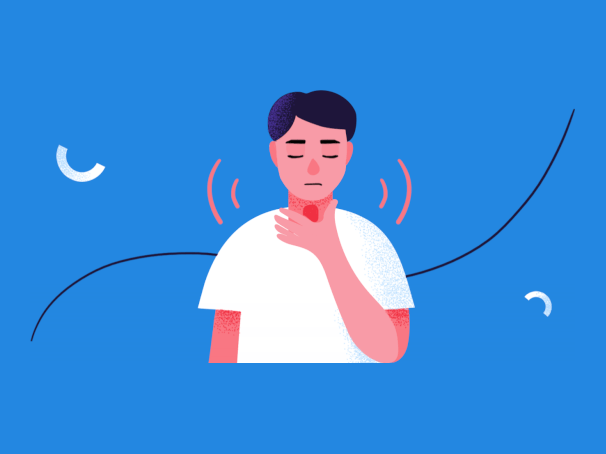
Anxiety, despite what many think, actually does have a “useful” purpose. While anxiety comes with many difficult symptoms, it also signals to your body when you should be afraid (when your "fight/flight" response should be activated). This physiological reaction occurs when a harmful event, attack, or threat is perceived.
Unfortunately, many people experience life with their fight or flight system constantly activated. For these individuals, the physiological reaction occurs regardless of whether something actually triggers it or not. This is hard, as the fight or flight response is quite strenuous on the body. One of the symptoms that many complain about is weak legs, or "jelly legs."
With jelly legs, standing can feel unusual and may be accompanied by dizziness or balance issues. The dizziness and/or balance problems may be related to the inherent leg weakness, or be an additional symptom of the overall anxiety.
What Creates the Jelly Leg Feeling?
There are several factors that may contribute to the feeling of jelly legs. One of the most common is a result of the adrenaline produced in response to the physiological response of “fight or flight.”
When adrenaline rushes through the body, blood goes to the places that your body feels need it most. That means that your blood is rushing to your heart, your brain, and possibly various muscles, and to do that it rushes out of your legs and makes them feel more like jelly.
Other Causes of Jelly Leg
The sensation of “jelly legs” may also be attributed to the muscle weakness that occurs when the body is flooded with adrenaline. Adrenaline causes the muscles to be in a constant state of tension, and eventually, they will become weak. Also, anxiety can cause changes to one’s breathing that can result in weakened muscles and changes in blood pressure.
How to Tell the Difference Between Anxiety Weak Legs and Something More Serious?
Many people suffering from jelly legs worry they are experiencing a more serious physical problem. While weak legs can be a scary feeling (in that it may feel difficult to stand), jelly legs are fairly common. Nonetheless, it is always appropriate to speak to a medical professional if there is a concern. A doctor can diagnose or rule out any potential underlying health issues. Yet, certain factors may help in determining if the jelly legs are a result of anxiety, or a more significant, underlying condition:
- Temporary - Generally, the sensation of jelly legs associated with anxiety is temporary. Weak legs tend to regain some of their strength when the anxiety dissipates. They may recur often as you go through anxiety, but they won't be a constant symptom.
- Strength - Usually weak legs due to anxiety will regain most of their strength. This is not entirely the case as dizziness and hyperventilation can genuinely cause legs to be a bit weaker than normal (as can adrenaline rushes), but leg strength is usually not affected - especially in the long term.
- Other Symptoms - Weak legs from anxiety are usually accompanied by other anxiety symptoms. Jelly legs from anxiety usually come with anxious thoughts, rapid heartbeat, and other signs of anxiety.
The problem with anxiety and jelly legs (along with the other difficult symptoms of anxiety) is in the difficulty determining the cause of the symptoms. Nevertheless, there are some general differences between anxiety and a more serious, underlying health condition that could help one recognize whether or not his or her experience is anxiety related.
How to Cure and Prevent Jelly Legs
Anxiety, while at times overwhelming, is treatable. There are ways to manage anxiety in the moment as well as long term treatment options.
Some tools and skills to help manage anxiety in the moment include:
- Go Walking - If you're not feeling too dizzy (a common symptom of anxiety), try going for a walk. Walking gets the blood flowing and it takes your mind off of your legs. It's also a reminder that you have leg strength.
- Close Your Eyes - If you do have a bit of dizziness leading to your weak leg feeling, close your eyes for a while as long it's safe to do so. Your weak legs are generally the result of feeling dizzy, so with your eyes closed that dizziness will affect you less.
- Mantra Meditation - There is some debate in the medical community about whether or not mantra meditation is beneficial for anxiety in the long term. However, in the short term, it can help calm you down because it acts as a breathing distraction. The mantras focus your mental energy away from your anxiety, while the meditation gets your breathing under control so that you experience less over-breathing.
These aren't long term solutions, but in the moment, using these skills may help decrease the intensity of the anxiety and alleviate some of the challenging symptoms, including weak legs.
Long-term treatment options may include:
There are various approaches to managing anxiety long-term. Some of these approaches may help decrease one’s vulnerability to anxiety altogether, or lessen the intensity of the anxiety when it is experienced.
- Herbal Solutions Several natural herbs are effective for controlling anxiety.
- Anxiety Medications Many medications can reduce anxiety, although they may come with side effects.
- Therapy Therapy can also be effective at reducing anxiety.
Generally, the best place to start is by thoroughly researching anxiety and getting an idea of which symptoms are affecting you and how.
SUMMARY:
The “jelly legs” feeling, which typically refers to feelings of weakness, dizziness, or loss of control in the legs, is often caused by a rush of adrenaline taking blood away from the legs, though there may be other causes. It is temporary, but can be distressing, and requires long term anxiety treatments to stop from recurring.












